|

|
|
|
|
Invasion of the trophoblast and embedding
|
|
The trophoblast differentiates into two different cell masses, shortly before it comes into contact with the endometrium:
- the outer syncytiotrophoblast (ST)
- the inner cytotrophoblast (CT)
|
|
The cytotrophoblast, deep inside, consists in an inner irregular layer of ovoid, single- nucleus cells. This is also where intensive mitotic activity takes place.
In the periphery the syncytiotrophoblast forms a syncytium, i.e., a multi-nucleic layer without cell boundaries that arises from the fusion of cytotrophoblast cells. The syncytiotrophoblast produces lytic enzymes and secretes factors that cause apoptosis of the endometrial epithelial cells. The syncytiotrophoblast also crosses the basal lamina and penetrates into the stroma that lies below, eroding the wall of capillaries. With the implantation of the blastocyst in the endometrium the syncytiotrophoblast develops quickly and will entirely surround the embryo as soon as it has completely embedded itself in the endometrium.
|
|
|
|
The uterine mucosa reacts to the implantation by the decidual reaction. The syncytiotrophoblast cells phagocytize the apoptotic decidual cells of the endometrium and resorb the proteins, sugars and lipids that have been formed there. They also erode the canals of the endometrial glands and the capillaries of the stroma.
|
|
|
| Fig. 18 - Implantation: 6th-7th day |
|
Fig. 19 - Implantation: 7th-8th day |
|
Legend |
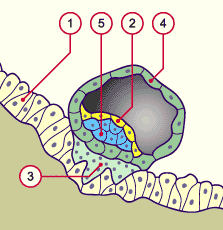
1
2
3
4 |
Epithelium of the uterine mucosa
Hypoblast
Syncytiotrophoblast
Cytotrophoblast |
|
|
|
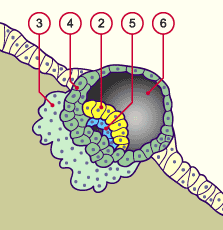
5
6
|
Epiblast
Blastocyst cavity |
|
|
|
Fig. 18
Free blastocyst (following the dissolution of the pellucid zone) in adplantation phase on the uterine wall (6th to 7th day). The trophoblast cells of the embryonic pole differentiate themselves, multiply, and form the invasive syncytiotrophoblast. The abembryonic pole consists of cytotrophoblast cells.
Fig. 19
Didermic embryonic disk (hypoblast and epiblast) after 8 days. The ST continues its invasive, lytic activity into the maternal tissue.
|
| Fig. 20 - Implantation: 8th day |
|
Fig. 21 - Implantation: 9th day |
|
Legend |
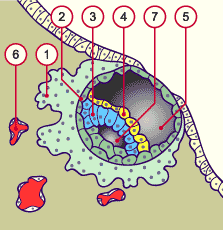
1
2
3
4
5
6
7 |
Syncytiotrophoblast (ST)
Cytotrophoblast (CT)
Epiblast
Hypoblast
Blastocyst cavity
Maternal blood capillary
Amniotic cavity |
|
|
|
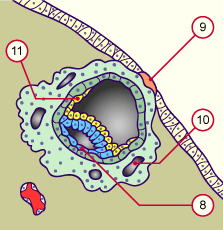
8
9
10
11 |
Amnioblasts
Fibrin plug
Trophoblast lacunae
Multiplying hypoblast |
|
|
|
Fig. 20, Fig. 21
Complete implantation of the embryo into the endometrium and covering of the implantation location by a fibrin plug.
The amniotic cavity expands and a cellular layer (amnioblasts) now separates it from the CT. The hypoblast cells also begin to multiply  5b 5b . Extracellular vacuoles appear in the ST and join to form lacunae. . Extracellular vacuoles appear in the ST and join to form lacunae.
|
|
In the middle of the 2nd week extracellular vacuoles appear in the ST. They join together forming lacunae. Initially these lacunae are filled with tissue fluids and uterine secretions. Following the erosion of the maternal capillaries, their blood fills the lacunae that later develop further into intervillous spaces. The invasive growth of the ST ceases in the zona compacta of the endometrium. At around the 13th day the primitive utero-placental circulatory system arises.
|
|
|
| Fig. 22 - Implantation: 9th-10th day |
|
Fig. 23 - Implantation: 10th-11th day |
|
Legend |
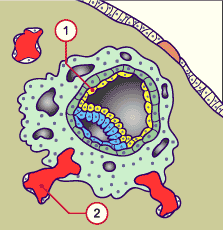
1
2
|
Hypoblast growing ventrally
Eroded maternal capillaries |
|
|
|
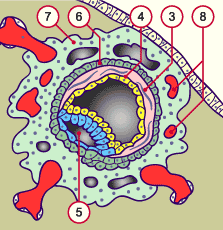
3
4
5
6
7
8 |
Extraembryonic reticulum
Heuser´s membrane
Amniotic cavity
Cytotrophoblast
Syncytiotrophoblast
Lacunae, filled with blood |
|
|
|
Fig. 22, Fig. 23
The destructive lytic activity of the ST reaches the capillaries of the endometrium. The maternal blood flows into the lacunae. The ST envelops the maternal capillaries, expands its lacunae network, and forms an arterial inflow and a venous outflow system.
|
|
At the end of the 2nd week, when implantation has ended, the embryonic bud consists schematically of two hemispheric cavities that lie on one another: the amniotic cavity (dorsal) and the umbilical vesicle (ventral).
The floor of the amniotic cavity is formed by the epiblast, and the roof of the umbilical vesicle by the hypoblast. These two layers, which lie on one another, form the embryo or the double-layered embryonic disc.
|
|
|
|
|

